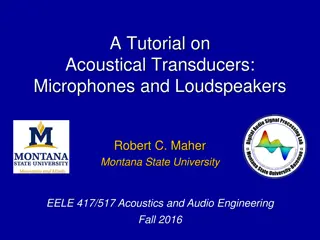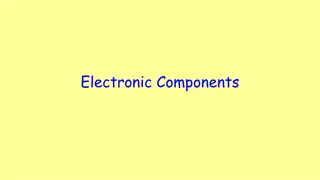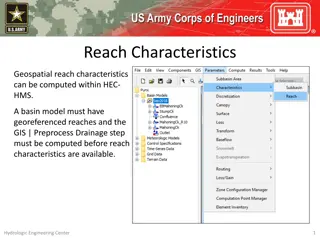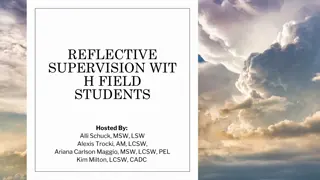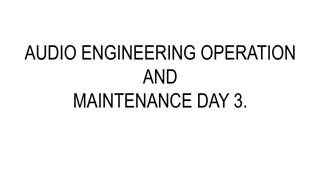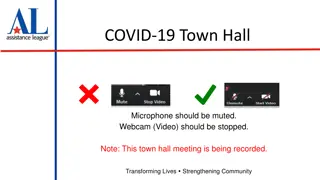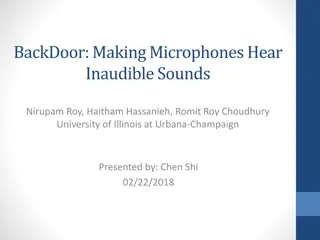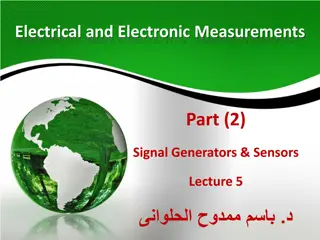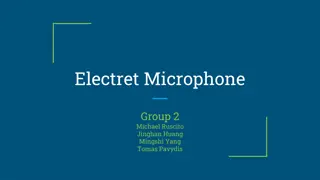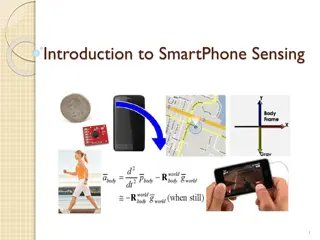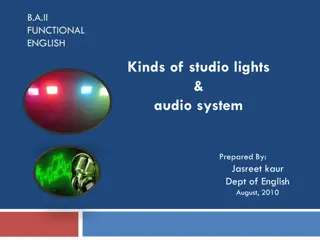Different Types and Characteristics of Microphones
In the world of microphones, understanding the transducer/element type, directional characteristics, and frequency response is crucial. Dynamic, condenser, and ribbon are the main transducer types, each with unique qualities and applications. Directional characteristics like cardioid, bi-directional, and omnidirectional affect how sound is captured and isolated. Explore the nuances of microphone technology to make informed choices for your recording needs.
Download Presentation

Please find below an Image/Link to download the presentation.
The content on the website is provided AS IS for your information and personal use only. It may not be sold, licensed, or shared on other websites without obtaining consent from the author.If you encounter any issues during the download, it is possible that the publisher has removed the file from their server.
You are allowed to download the files provided on this website for personal or commercial use, subject to the condition that they are used lawfully. All files are the property of their respective owners.
The content on the website is provided AS IS for your information and personal use only. It may not be sold, licensed, or shared on other websites without obtaining consent from the author.
E N D
Presentation Transcript
Transmission-Line Theory We need transmission-line theory whenever the length of a line is significant compared to a wavelength. L 2
Transmission Line 2 conductors: c1=signal, c2=ground 4 per-unit-length parameters: C= capacitance/length [F/m] z L= inductance/length [H/m] R= resistance/length [ /m] G= conductance/length [ /m or S/m] 3
Transmission Line (cont.) ( ) , i z t ( ) + + + + + + + - - - - - - - - - - , v z t x x x B z ( ) R z ( ) + , i z z t L z , i z t + + ( ( ) ) + , v z z t G z C z , v z t - - z Note: There are equal and opposite currents on the two conductors. (We only need to work with the current on the top conductor, since we have chosen to put all of the series elements there.) 4
Transmission Line (cont.) ( ) R z ( ) + , i z z t L z , i z t + + ( ( ) ) + , v z z t G z C z , v z t - - z ( , ) i z t t = + + + ( , ) v z t ( , ) z t ( , ) i z t R z v z L z v z + ( , ) z t = + + , ) z t G z + + ( , ) i z t ( , ) z t ( i z v z C z t 5
TEM Transmission Line (cont.) Hence + ( , ) z t ( , ) v z t ( , ) i z t t v z = ( , ) Ri z t L z + v z + ( , ) z t ( , ) i z t ( , ) z t i z = + ( , ) z t Gv z C z t Now let z 0: v z i z i t = Ri L Telegrapher s Equations v t = Gv C 6
TEM Transmission Line (cont.) To combine these, take the derivative of the first one with respect to z: v i z i z i t i z 2 = R L z z 2 Switch the order of the derivatives. = R L t v t v t v 2 = R Gv C L G C t 2 i z v t = Gv C 7
TEM Transmission Line (cont.) v v t v t v 2 2 = Gv C R L G C z t 2 2 Hence, we have: v v t v 2 2 ( ) + = ( ) 0 RG v RC LG LC z t 2 2 The same differential equation also holds for i. Note: There is no exact solution in the time domain, in the lossy case. 8
TEM Transmission Line (cont.) Time-Harmonic (=Sinusoidal) Waves: j = + = ( ) v t cos( ), (phasor of ), A t V Ae v j t v v t v 2 2 ( ) + = ( ) 0 RG v RC LG LC z t 2 2 d V dz 2 ( ) + = ( ) ( ) 0 RG V RC LG j V LC V 2 2 9
TEM Transmission Line (cont.) d V dz 2 ( ) ( ) = + + ( ) RG V j RC LG V LC V 2 2 Note that + + = + j L G + j C ( ) ( )( ) RG j RC LG LC R 2 = = + + Z Y R G j L j C = = series impedance / unit length parallel admittance / unit length d V dz 2 = ( ) ZY V Then we can write: 2 10
Phasor Domain Phasor counterpart of
Time and Phasor Domain It is much easier to deal with exponentials in the phasor domain than sinusoidal relations in the time domain Just need to track magnitude/phase, knowing that everything is at frequency
Complex Numbers We will find it is useful to represent sinusoids as complex numbers = 1 j ( ) z Rectangular coordinates Polar coordinates = + z x jy = Re z x = = = je Im( ) z z z y Relations based on Euler s Identity j = cos sin e j
TEM Transmission Line (cont.) ( ) d V z dz 2 ( ) = V z ZY 2 Then Define 2 2 Solution: + z z = + ( ) V z Ae Be z : voltage wave propagating in + direction Ae z + z : voltage wave propagating in direction Be z is called the propagation constant . We have: 1/2 = + j L G + j C ( )( ) R Question: Which sign of the square root is correct? 14
TEM Transmission Line (cont.) 1/2 = + j L G + j C ( )( ) R We choose the principal square root. re = j Principal square root: z r e = /2 j z (Note the square-root ( radical ) symbol here.) ( ) z Re 0 Hence = + j L G + j C ( )( ) R Re 0 15
TEM Transmission Line (cont.) = + j L G + j C ( )( ) R = + j Denote: = propagation constant 1/m = phaseconstant rad/m = attenuationcontant [np/m] = Re 0 16
TEM Transmission Line (cont.) Wave traveling in +z direction: ( ) ( ) j z = = z z = + V z Ae Ae e j Wave is attenuating as it propagates. Wave traveling in z direction: ( ) ( ) = + + + + j z = = j z z V z Ae Ae e Wave is attenuating as it propagates. 17
TEM Transmission Line (cont.) ( ) j z = z Attenuation in dB/m: V z Ae e V V = Attenuation in dB 20log out 10 in z A e = 20log 10 A ( )( ) = = 20 0.4343 8.686 z z ( ) x ( ) x = Note: log 0.4343 ln 10 = (dB/m) Np: neper, 1 Np = 8.686 (Np/m) e = 1 0.37 18
Wavenumber Notation ( ) j z = = z z = + V z Ae Ae e j ( ) j z = = = jk z z zk j V z Ae Ae e z = jk z = + j L G + j C ( )( ) R "(complex) propagationconstant" = + j L G + j C ( )( ) zk j R "(complex) wavenumber" 19
TEM Transmission Line (cont.) Forward travelling wave (a wave traveling in the positive z direction): + + + j z z z = = ( ) z ( ( V V e V e e 0 0 ) + + j z j t z = ( , ) z t Re v V e e e 0 ) ( ) + j z j t j z = Re V e e e e 0 ( ) + z = + cos V e t z The wave repeats when: 0 = 2 g t = 0 g Hence: + z V e 0 2 = z g snapshot of wave 20
Phase Velocity Let s track the velocity of a fixed point on the wave (a point of constant phase), e.g., the crest of the wave. p v (phase velocity) z + + z = + ( , ) z t cos( ) v V e t z 0 21
Phase Velocity (cont.) = t z constant Set dz dt dz dt = 0 = = v Hence p 22
Characteristic Impedance Z0 ( ) z + I + ( ) z + V z Assumption: A wave is traveling in the positive z direction. + ( ) : characteristic impedance ( ) z V I z Z 0 + + V I + + z = 0 + = ( ) z V V e so Z 0 0 0 + + z = ( ) z I I e 0 (Note: Z0 is a number, not a function of z.) 23
Characteristic Impedance Z0(cont.) Use first Telegrapher s Equation: v z i t = Ri L so dV dz = j LI = RI ZI + + = = z ( ) z V V e 0 + Recall: + z ( ) z I I e 0 + + V e = z z ZI e Hence 0 0 24
Characteristic Impedance Z0(cont.) + V I Z Z ZY 0 + From this we have: = = = Z 0 0 Use: = = + + Z Y R G j L j C Both are in the first quadrant = ZY first quadrant = / Z Z ZY right -half plane 0 Re 0 Z 0 Z Y = Z (principal square root) 0 25
Characteristic Impedance Z0(cont.) Hence, we have + + Z Y R G j L j C = = Z 0 26
RLGC from Z0 and + + 1 Z Y R G j L j C = = Z 0 Y 0 = + j L G + j C ( )( ) R = + j L = + j C , Z R Y G 0 0 = Re( ) R Z 0 = Im( )/ L Z 0 = Re( ) G Y 0 = Im( )/ C Y 0 27
General Case (Waves in Both Directions) ( ) + + z z = + V z V e V e 0 0 + + + + j z j z j z j z = + V e e e V e e e 0 0 Wave in +z direction Wave in -z direction In the time domain: ( ) ( ) j t = , R e v z t V z e ( ) + + z = + cos V e t z 0 ( ) + z + + + c os V e t z 0 28
Backward-Traveling Wave ( ) z I + ( ) z V z A wave is traveling in the negative z direction. ( ) ( ) z V z ( ) ( ) z V I z = Z = so Z 0 0 I Note: The reference directions for voltage and current are chosen the same as for the forward wave. 30
General Case ( ) I z + ( ) V z z A general superposition of forward and backward traveling waves: Most general case: + + z z = + ( ) V z V e V e 0 0 1 + + V e z z = ( ) I z V e 0 0 Z 0 31
Summary of Basic TL formulas ( ) I z + ( ) V z ( ) + + z z = + V z V e V e 0 0 Guided wavelength: + V Z V Z ( ) I z + z z 0 0 = e e 2 m = g 0 0 ( )( ) = + = + j L G + j C j R Phase velocity: + + R G j L j = Z 0 C = [m/s] v p = 8.686 Attenuation in dB/m 32
Small Loss Case L G , R C = + = + j L G + j C ( )( ) j R R R C R G = j L j C ( )( ) 1 1 1 1 j j j LC j j 2 2 L L C 1 2 R Z G Y = + 0 0 RG = LC LC 4 LC R j L 1 j L C R G L = = + 1 1 Z j j 0 2 2 R C L C j C 1 j L C RG 2 L C R G = + 1 j 2 2 L C 4 LC 33
Lossless Case = = 0, 0 R G = + = + j L G + j C ( )( ) j R = j LC = = 0 = v p so LC + + R G j L j C 1 LC L C = = Z = v Z 0 p 0 (independent of freq.) (real and independent of freq.) 34
01-Python: Z0,gamma from R,L,G,C # Transmission Line: Z0,gamma from R,L,G,C # Sample values: RG-59 coaxial cable # Input: R=36e-3 ohm/m, L=430e-9 H/m, G=10e-6 S/m, C=69e-12 F/m, f=100e6 Hz # Output: # Z0=(78.94228228730861+0.0038450155279376556j) # gamma=(0.0006227261020735598+3.4224620530010226j) import cmath pi=3.14159265 while True: R=float(input('R(ohm/m)=')) L=float(input('L(H/m)=')) G=float(input('G(S/m)=')) C=float(input('C(F/m)=')) while True: f=float(input('f(Hz)=(negative to stop)')) if f < 0: break Z=complex(R,2*pi*f*L); Y=complex(G,2*pi*f*C) Z0=cmath.sqrt(Z/Y); gamma=cmath.sqrt(Z*Y) print('Z0(ohm)=',Z0) print('gamma(per meter)=',gamma) (proof given later) 40
https://www.online-python.com/ copy [Run] prompt . (proof given later) 41
Python cmath - python cmath modules - . (proof given later) 43




